UMACTA-30-M Financial Accounting: Cash Flow Analysis Report
VerifiedAdded on 2023/01/19
|13
|2233
|71
Report
AI Summary
This report analyzes the financial performance and investment potential of Working Computers PLC's Bernoulli division, focusing on cash flow analysis and investment appraisal techniques. The report begins with an introduction to fundamental accounting principles and the context of the investment project, including the declining market share of the Bernoulli device and the need for a new capital investment plan. It then delves into the proposed investment, free cash flow, terminal value, and sensitivity analysis to evaluate the financial impact of the investment. The report examines potential sources of finance, including long-term and short-term options, and recommends an optimal balance to minimize the Weighted Average Cost of Capital (WACC). It uses the Net Present Value (NPV) method and Internal Rate of Return (IRR) to assess the investment's feasibility, considering projected cash flows, cost of capital, and inflation. The report also discusses the gap between financial theory and practice, highlighting the relevance of NPV and other investment appraisal methods. Finally, the report concludes with a recommendation to adopt the proposed investment, based on the positive NPV and IRR results, and advises the board of managers to proceed with the investment. Appendices provide detailed financial data and calculations supporting the analysis.

FINANCIAL ACCOUNTING
CASH FLOWS
CASH FLOWS
Paraphrase This Document
Need a fresh take? Get an instant paraphrase of this document with our AI Paraphraser
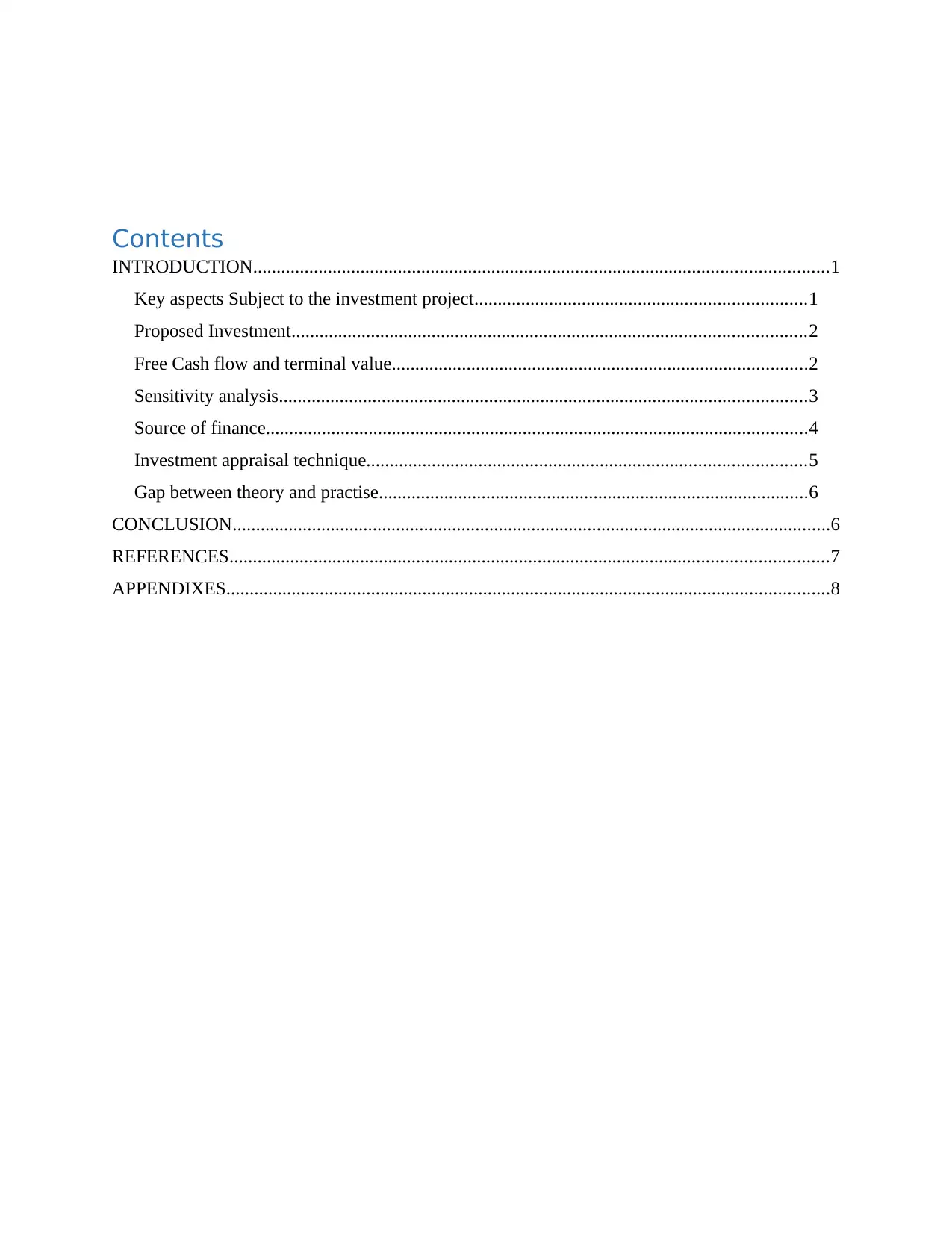
Contents
INTRODUCTION...........................................................................................................................1
Key aspects Subject to the investment project.......................................................................1
Proposed Investment..............................................................................................................2
Free Cash flow and terminal value.........................................................................................2
Sensitivity analysis.................................................................................................................3
Source of finance....................................................................................................................4
Investment appraisal technique..............................................................................................5
Gap between theory and practise............................................................................................6
CONCLUSION................................................................................................................................6
REFERENCES................................................................................................................................7
APPENDIXES.................................................................................................................................8
INTRODUCTION...........................................................................................................................1
Key aspects Subject to the investment project.......................................................................1
Proposed Investment..............................................................................................................2
Free Cash flow and terminal value.........................................................................................2
Sensitivity analysis.................................................................................................................3
Source of finance....................................................................................................................4
Investment appraisal technique..............................................................................................5
Gap between theory and practise............................................................................................6
CONCLUSION................................................................................................................................6
REFERENCES................................................................................................................................7
APPENDIXES.................................................................................................................................8
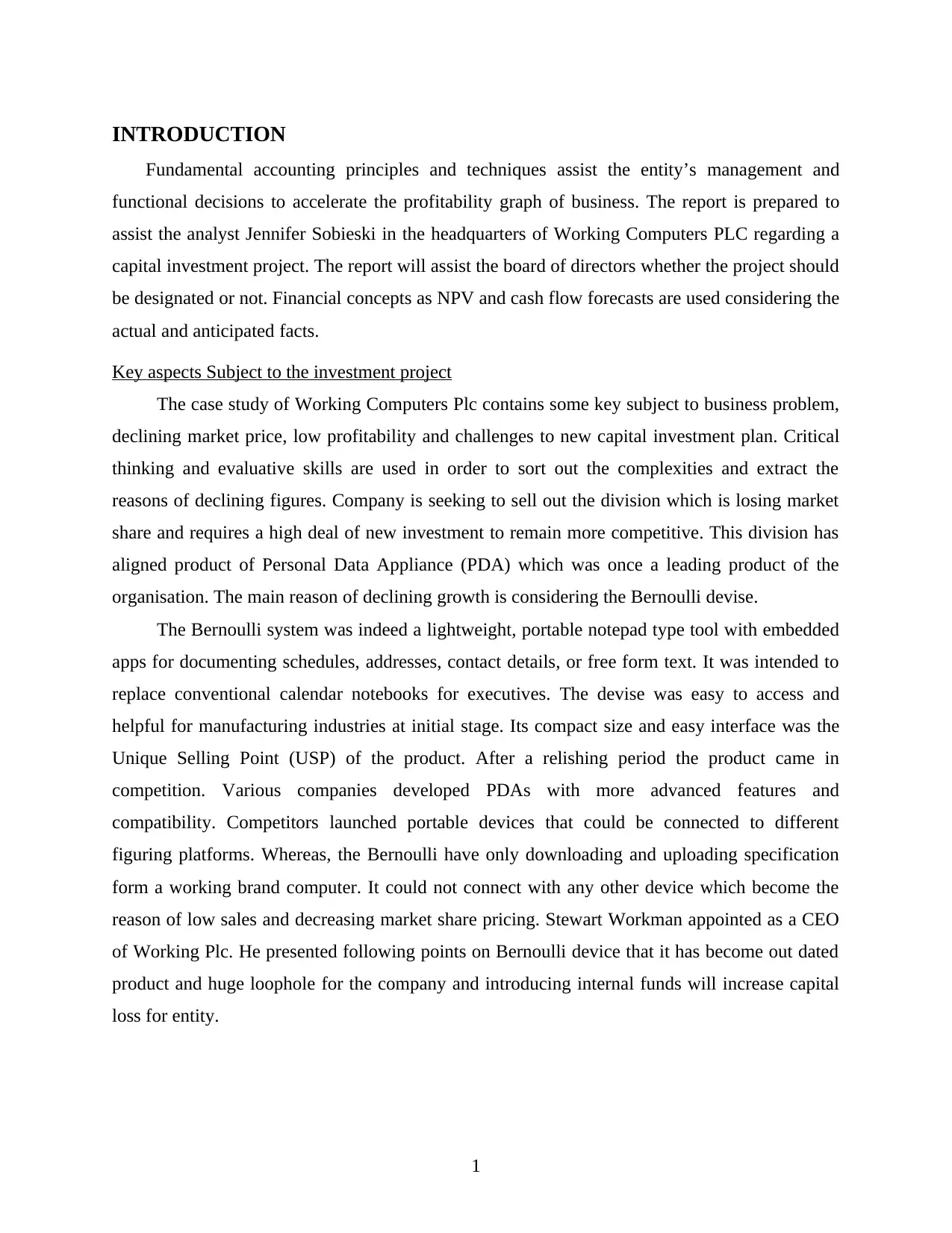
INTRODUCTION
Fundamental accounting principles and techniques assist the entity’s management and
functional decisions to accelerate the profitability graph of business. The report is prepared to
assist the analyst Jennifer Sobieski in the headquarters of Working Computers PLC regarding a
capital investment project. The report will assist the board of directors whether the project should
be designated or not. Financial concepts as NPV and cash flow forecasts are used considering the
actual and anticipated facts.
Key aspects Subject to the investment project
The case study of Working Computers Plc contains some key subject to business problem,
declining market price, low profitability and challenges to new capital investment plan. Critical
thinking and evaluative skills are used in order to sort out the complexities and extract the
reasons of declining figures. Company is seeking to sell out the division which is losing market
share and requires a high deal of new investment to remain more competitive. This division has
aligned product of Personal Data Appliance (PDA) which was once a leading product of the
organisation. The main reason of declining growth is considering the Bernoulli devise.
The Bernoulli system was indeed a lightweight, portable notepad type tool with embedded
apps for documenting schedules, addresses, contact details, or free form text. It was intended to
replace conventional calendar notebooks for executives. The devise was easy to access and
helpful for manufacturing industries at initial stage. Its compact size and easy interface was the
Unique Selling Point (USP) of the product. After a relishing period the product came in
competition. Various companies developed PDAs with more advanced features and
compatibility. Competitors launched portable devices that could be connected to different
figuring platforms. Whereas, the Bernoulli have only downloading and uploading specification
form a working brand computer. It could not connect with any other device which become the
reason of low sales and decreasing market share pricing. Stewart Workman appointed as a CEO
of Working Plc. He presented following points on Bernoulli device that it has become out dated
product and huge loophole for the company and introducing internal funds will increase capital
loss for entity.
1
Fundamental accounting principles and techniques assist the entity’s management and
functional decisions to accelerate the profitability graph of business. The report is prepared to
assist the analyst Jennifer Sobieski in the headquarters of Working Computers PLC regarding a
capital investment project. The report will assist the board of directors whether the project should
be designated or not. Financial concepts as NPV and cash flow forecasts are used considering the
actual and anticipated facts.
Key aspects Subject to the investment project
The case study of Working Computers Plc contains some key subject to business problem,
declining market price, low profitability and challenges to new capital investment plan. Critical
thinking and evaluative skills are used in order to sort out the complexities and extract the
reasons of declining figures. Company is seeking to sell out the division which is losing market
share and requires a high deal of new investment to remain more competitive. This division has
aligned product of Personal Data Appliance (PDA) which was once a leading product of the
organisation. The main reason of declining growth is considering the Bernoulli devise.
The Bernoulli system was indeed a lightweight, portable notepad type tool with embedded
apps for documenting schedules, addresses, contact details, or free form text. It was intended to
replace conventional calendar notebooks for executives. The devise was easy to access and
helpful for manufacturing industries at initial stage. Its compact size and easy interface was the
Unique Selling Point (USP) of the product. After a relishing period the product came in
competition. Various companies developed PDAs with more advanced features and
compatibility. Competitors launched portable devices that could be connected to different
figuring platforms. Whereas, the Bernoulli have only downloading and uploading specification
form a working brand computer. It could not connect with any other device which become the
reason of low sales and decreasing market share pricing. Stewart Workman appointed as a CEO
of Working Plc. He presented following points on Bernoulli device that it has become out dated
product and huge loophole for the company and introducing internal funds will increase capital
loss for entity.
1
⊘ This is a preview!⊘
Do you want full access?
Subscribe today to unlock all pages.

Trusted by 1+ million students worldwide
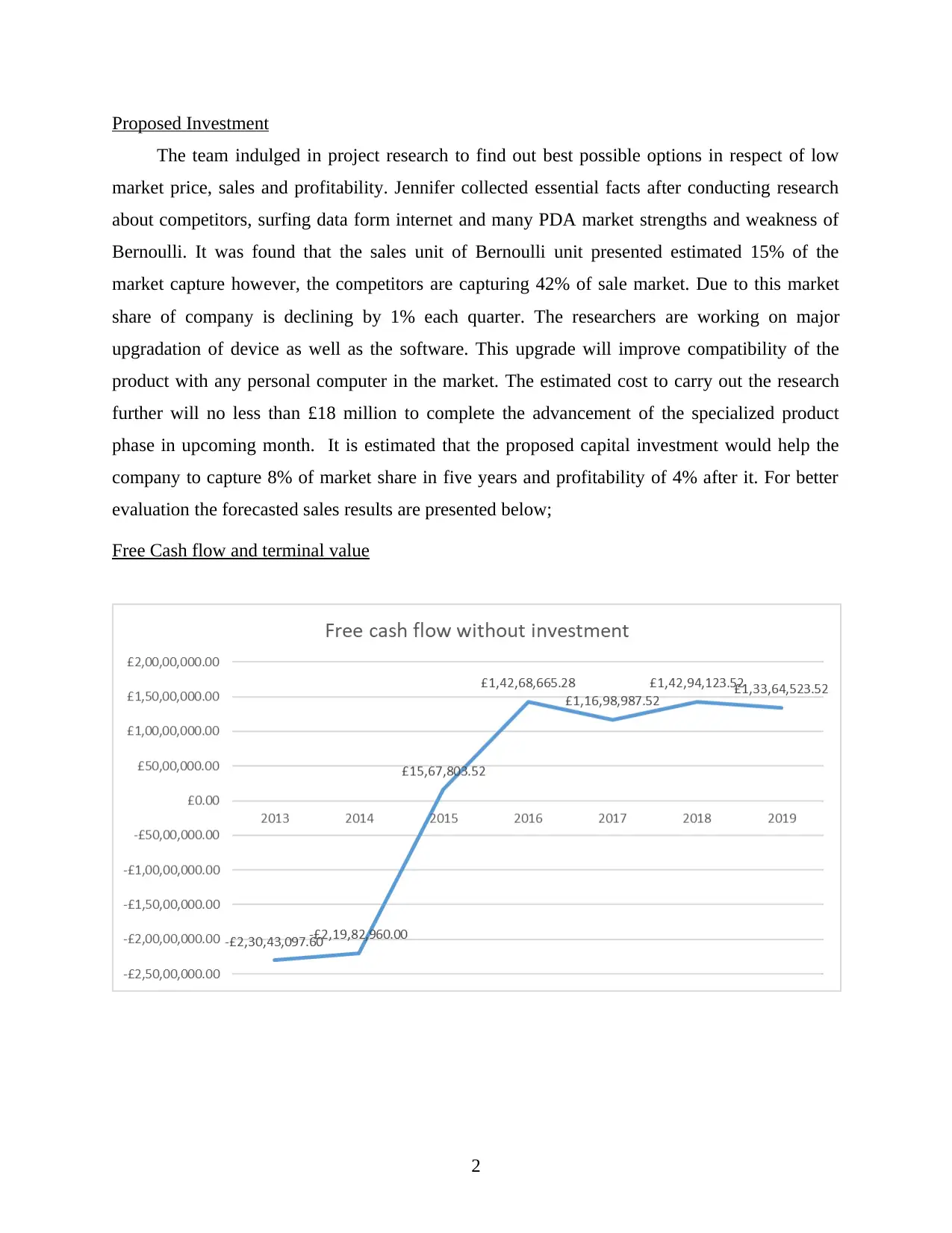
Proposed Investment
The team indulged in project research to find out best possible options in respect of low
market price, sales and profitability. Jennifer collected essential facts after conducting research
about competitors, surfing data form internet and many PDA market strengths and weakness of
Bernoulli. It was found that the sales unit of Bernoulli unit presented estimated 15% of the
market capture however, the competitors are capturing 42% of sale market. Due to this market
share of company is declining by 1% each quarter. The researchers are working on major
upgradation of device as well as the software. This upgrade will improve compatibility of the
product with any personal computer in the market. The estimated cost to carry out the research
further will no less than £18 million to complete the advancement of the specialized product
phase in upcoming month. It is estimated that the proposed capital investment would help the
company to capture 8% of market share in five years and profitability of 4% after it. For better
evaluation the forecasted sales results are presented below;
Free Cash flow and terminal value
2
The team indulged in project research to find out best possible options in respect of low
market price, sales and profitability. Jennifer collected essential facts after conducting research
about competitors, surfing data form internet and many PDA market strengths and weakness of
Bernoulli. It was found that the sales unit of Bernoulli unit presented estimated 15% of the
market capture however, the competitors are capturing 42% of sale market. Due to this market
share of company is declining by 1% each quarter. The researchers are working on major
upgradation of device as well as the software. This upgrade will improve compatibility of the
product with any personal computer in the market. The estimated cost to carry out the research
further will no less than £18 million to complete the advancement of the specialized product
phase in upcoming month. It is estimated that the proposed capital investment would help the
company to capture 8% of market share in five years and profitability of 4% after it. For better
evaluation the forecasted sales results are presented below;
Free Cash flow and terminal value
2
Paraphrase This Document
Need a fresh take? Get an instant paraphrase of this document with our AI Paraphraser
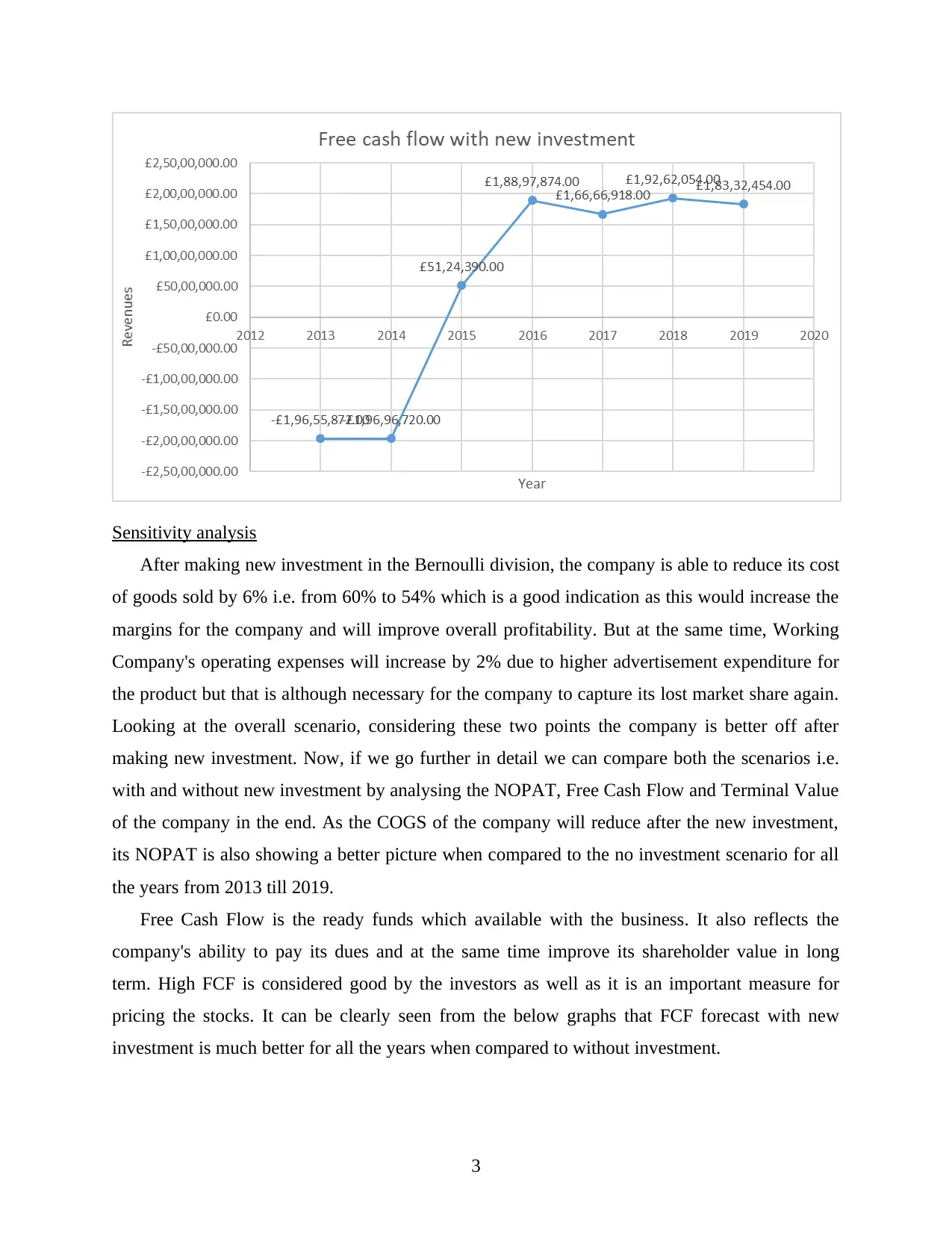
Sensitivity analysis
After making new investment in the Bernoulli division, the company is able to reduce its cost
of goods sold by 6% i.e. from 60% to 54% which is a good indication as this would increase the
margins for the company and will improve overall profitability. But at the same time, Working
Company's operating expenses will increase by 2% due to higher advertisement expenditure for
the product but that is although necessary for the company to capture its lost market share again.
Looking at the overall scenario, considering these two points the company is better off after
making new investment. Now, if we go further in detail we can compare both the scenarios i.e.
with and without new investment by analysing the NOPAT, Free Cash Flow and Terminal Value
of the company in the end. As the COGS of the company will reduce after the new investment,
its NOPAT is also showing a better picture when compared to the no investment scenario for all
the years from 2013 till 2019.
Free Cash Flow is the ready funds which available with the business. It also reflects the
company's ability to pay its dues and at the same time improve its shareholder value in long
term. High FCF is considered good by the investors as well as it is an important measure for
pricing the stocks. It can be clearly seen from the below graphs that FCF forecast with new
investment is much better for all the years when compared to without investment.
3
After making new investment in the Bernoulli division, the company is able to reduce its cost
of goods sold by 6% i.e. from 60% to 54% which is a good indication as this would increase the
margins for the company and will improve overall profitability. But at the same time, Working
Company's operating expenses will increase by 2% due to higher advertisement expenditure for
the product but that is although necessary for the company to capture its lost market share again.
Looking at the overall scenario, considering these two points the company is better off after
making new investment. Now, if we go further in detail we can compare both the scenarios i.e.
with and without new investment by analysing the NOPAT, Free Cash Flow and Terminal Value
of the company in the end. As the COGS of the company will reduce after the new investment,
its NOPAT is also showing a better picture when compared to the no investment scenario for all
the years from 2013 till 2019.
Free Cash Flow is the ready funds which available with the business. It also reflects the
company's ability to pay its dues and at the same time improve its shareholder value in long
term. High FCF is considered good by the investors as well as it is an important measure for
pricing the stocks. It can be clearly seen from the below graphs that FCF forecast with new
investment is much better for all the years when compared to without investment.
3
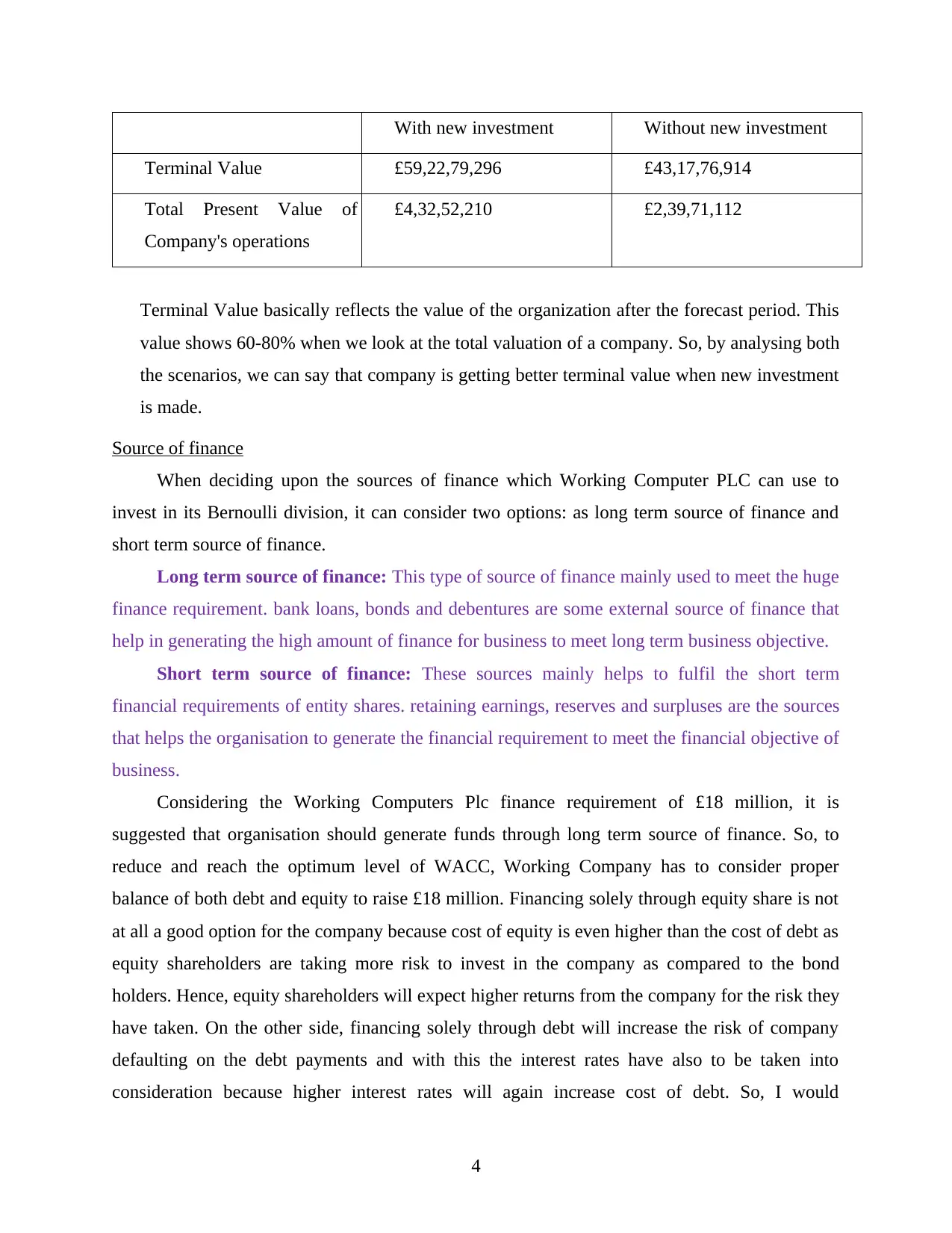
With new investment Without new investment
Terminal Value £59,22,79,296 £43,17,76,914
Total Present Value of
Company's operations
£4,32,52,210 £2,39,71,112
Terminal Value basically reflects the value of the organization after the forecast period. This
value shows 60-80% when we look at the total valuation of a company. So, by analysing both
the scenarios, we can say that company is getting better terminal value when new investment
is made.
Source of finance
When deciding upon the sources of finance which Working Computer PLC can use to
invest in its Bernoulli division, it can consider two options: as long term source of finance and
short term source of finance.
Long term source of finance: This type of source of finance mainly used to meet the huge
finance requirement. bank loans, bonds and debentures are some external source of finance that
help in generating the high amount of finance for business to meet long term business objective.
Short term source of finance: These sources mainly helps to fulfil the short term
financial requirements of entity shares. retaining earnings, reserves and surpluses are the sources
that helps the organisation to generate the financial requirement to meet the financial objective of
business.
Considering the Working Computers Plc finance requirement of £18 million, it is
suggested that organisation should generate funds through long term source of finance. So, to
reduce and reach the optimum level of WACC, Working Company has to consider proper
balance of both debt and equity to raise £18 million. Financing solely through equity share is not
at all a good option for the company because cost of equity is even higher than the cost of debt as
equity shareholders are taking more risk to invest in the company as compared to the bond
holders. Hence, equity shareholders will expect higher returns from the company for the risk they
have taken. On the other side, financing solely through debt will increase the risk of company
defaulting on the debt payments and with this the interest rates have also to be taken into
consideration because higher interest rates will again increase cost of debt. So, I would
4
Terminal Value £59,22,79,296 £43,17,76,914
Total Present Value of
Company's operations
£4,32,52,210 £2,39,71,112
Terminal Value basically reflects the value of the organization after the forecast period. This
value shows 60-80% when we look at the total valuation of a company. So, by analysing both
the scenarios, we can say that company is getting better terminal value when new investment
is made.
Source of finance
When deciding upon the sources of finance which Working Computer PLC can use to
invest in its Bernoulli division, it can consider two options: as long term source of finance and
short term source of finance.
Long term source of finance: This type of source of finance mainly used to meet the huge
finance requirement. bank loans, bonds and debentures are some external source of finance that
help in generating the high amount of finance for business to meet long term business objective.
Short term source of finance: These sources mainly helps to fulfil the short term
financial requirements of entity shares. retaining earnings, reserves and surpluses are the sources
that helps the organisation to generate the financial requirement to meet the financial objective of
business.
Considering the Working Computers Plc finance requirement of £18 million, it is
suggested that organisation should generate funds through long term source of finance. So, to
reduce and reach the optimum level of WACC, Working Company has to consider proper
balance of both debt and equity to raise £18 million. Financing solely through equity share is not
at all a good option for the company because cost of equity is even higher than the cost of debt as
equity shareholders are taking more risk to invest in the company as compared to the bond
holders. Hence, equity shareholders will expect higher returns from the company for the risk they
have taken. On the other side, financing solely through debt will increase the risk of company
defaulting on the debt payments and with this the interest rates have also to be taken into
consideration because higher interest rates will again increase cost of debt. So, I would
4
⊘ This is a preview!⊘
Do you want full access?
Subscribe today to unlock all pages.

Trusted by 1+ million students worldwide
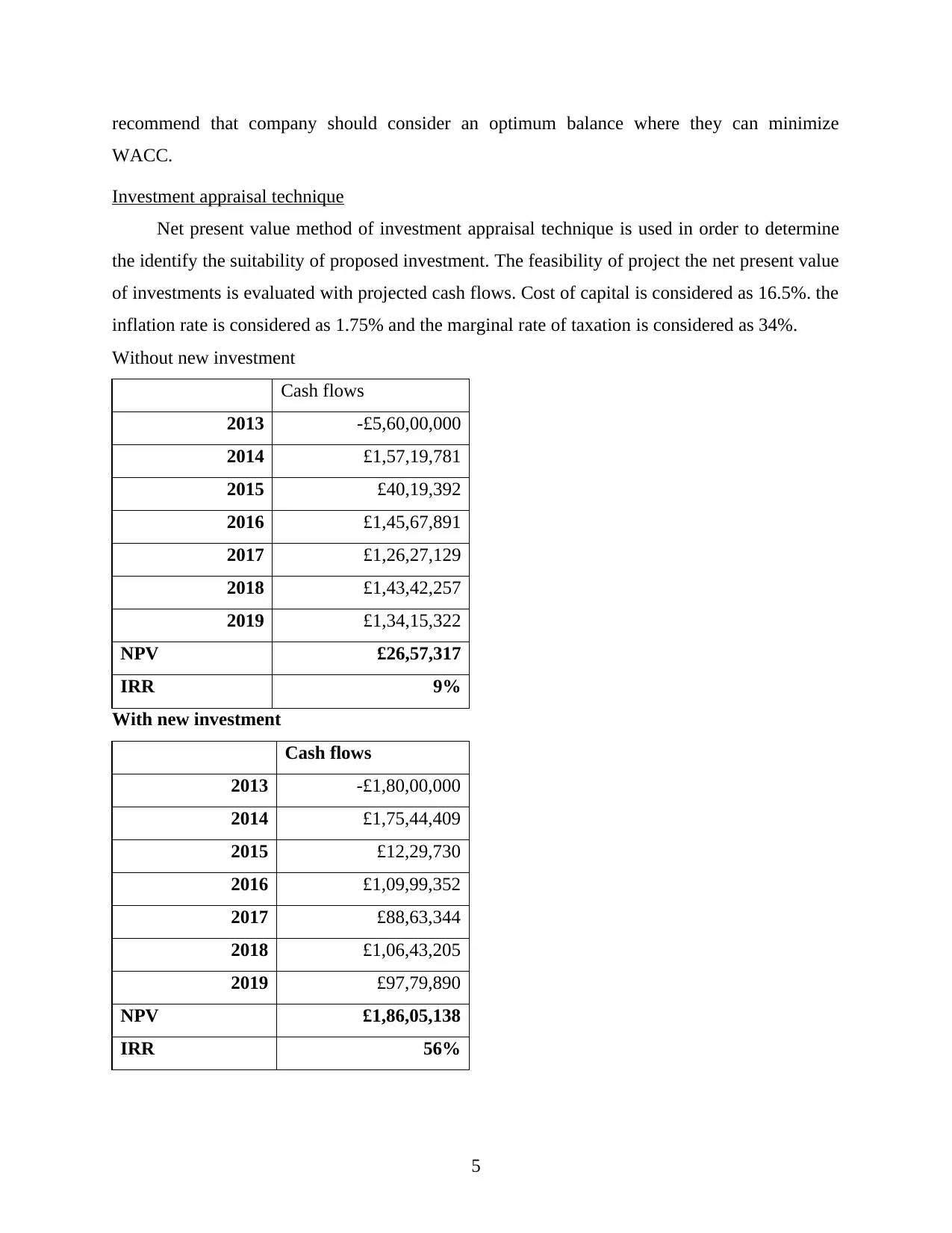
recommend that company should consider an optimum balance where they can minimize
WACC.
Investment appraisal technique
Net present value method of investment appraisal technique is used in order to determine
the identify the suitability of proposed investment. The feasibility of project the net present value
of investments is evaluated with projected cash flows. Cost of capital is considered as 16.5%. the
inflation rate is considered as 1.75% and the marginal rate of taxation is considered as 34%.
Without new investment
Cash flows
2013 -£5,60,00,000
2014 £1,57,19,781
2015 £40,19,392
2016 £1,45,67,891
2017 £1,26,27,129
2018 £1,43,42,257
2019 £1,34,15,322
NPV £26,57,317
IRR 9%
With new investment
Cash flows
2013 -£1,80,00,000
2014 £1,75,44,409
2015 £12,29,730
2016 £1,09,99,352
2017 £88,63,344
2018 £1,06,43,205
2019 £97,79,890
NPV £1,86,05,138
IRR 56%
5
WACC.
Investment appraisal technique
Net present value method of investment appraisal technique is used in order to determine
the identify the suitability of proposed investment. The feasibility of project the net present value
of investments is evaluated with projected cash flows. Cost of capital is considered as 16.5%. the
inflation rate is considered as 1.75% and the marginal rate of taxation is considered as 34%.
Without new investment
Cash flows
2013 -£5,60,00,000
2014 £1,57,19,781
2015 £40,19,392
2016 £1,45,67,891
2017 £1,26,27,129
2018 £1,43,42,257
2019 £1,34,15,322
NPV £26,57,317
IRR 9%
With new investment
Cash flows
2013 -£1,80,00,000
2014 £1,75,44,409
2015 £12,29,730
2016 £1,09,99,352
2017 £88,63,344
2018 £1,06,43,205
2019 £97,79,890
NPV £1,86,05,138
IRR 56%
5
Paraphrase This Document
Need a fresh take? Get an instant paraphrase of this document with our AI Paraphraser
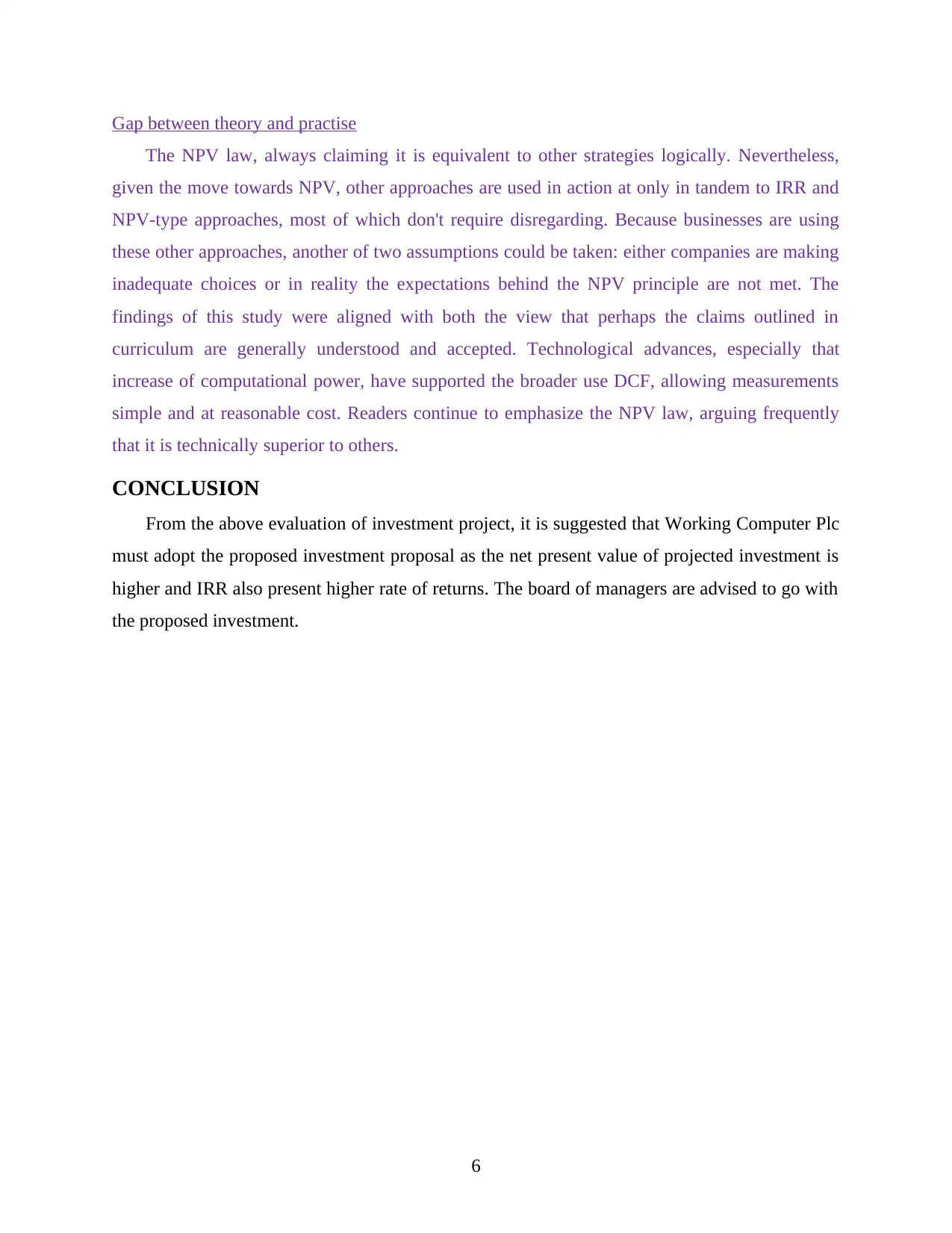
Gap between theory and practise
The NPV law, always claiming it is equivalent to other strategies logically. Nevertheless,
given the move towards NPV, other approaches are used in action at only in tandem to IRR and
NPV-type approaches, most of which don't require disregarding. Because businesses are using
these other approaches, another of two assumptions could be taken: either companies are making
inadequate choices or in reality the expectations behind the NPV principle are not met. The
findings of this study were aligned with both the view that perhaps the claims outlined in
curriculum are generally understood and accepted. Technological advances, especially that
increase of computational power, have supported the broader use DCF, allowing measurements
simple and at reasonable cost. Readers continue to emphasize the NPV law, arguing frequently
that it is technically superior to others.
CONCLUSION
From the above evaluation of investment project, it is suggested that Working Computer Plc
must adopt the proposed investment proposal as the net present value of projected investment is
higher and IRR also present higher rate of returns. The board of managers are advised to go with
the proposed investment.
6
The NPV law, always claiming it is equivalent to other strategies logically. Nevertheless,
given the move towards NPV, other approaches are used in action at only in tandem to IRR and
NPV-type approaches, most of which don't require disregarding. Because businesses are using
these other approaches, another of two assumptions could be taken: either companies are making
inadequate choices or in reality the expectations behind the NPV principle are not met. The
findings of this study were aligned with both the view that perhaps the claims outlined in
curriculum are generally understood and accepted. Technological advances, especially that
increase of computational power, have supported the broader use DCF, allowing measurements
simple and at reasonable cost. Readers continue to emphasize the NPV law, arguing frequently
that it is technically superior to others.
CONCLUSION
From the above evaluation of investment project, it is suggested that Working Computer Plc
must adopt the proposed investment proposal as the net present value of projected investment is
higher and IRR also present higher rate of returns. The board of managers are advised to go with
the proposed investment.
6
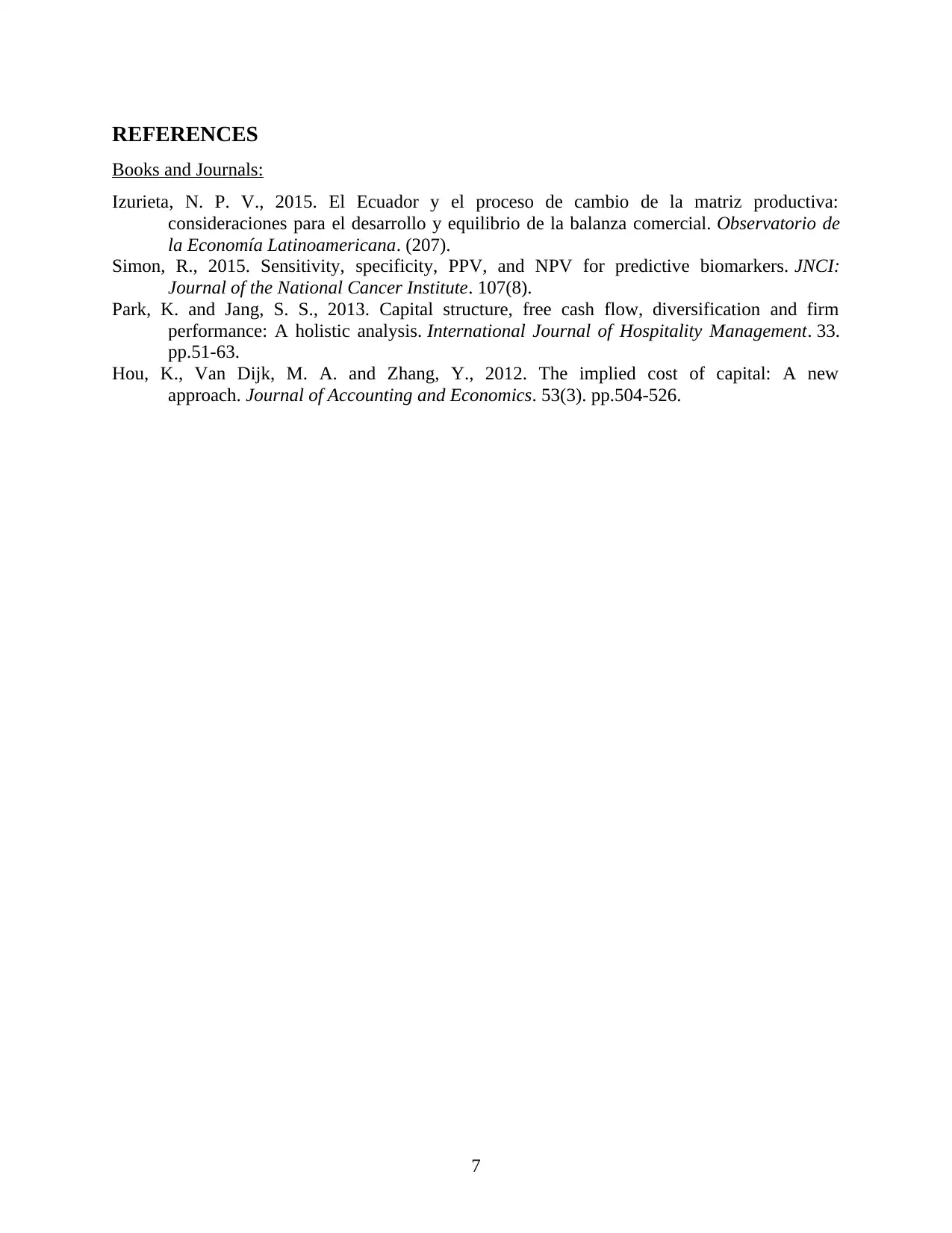
REFERENCES
Books and Journals:
Izurieta, N. P. V., 2015. El Ecuador y el proceso de cambio de la matriz productiva:
consideraciones para el desarrollo y equilibrio de la balanza comercial. Observatorio de
la Economía Latinoamericana. (207).
Simon, R., 2015. Sensitivity, specificity, PPV, and NPV for predictive biomarkers. JNCI:
Journal of the National Cancer Institute. 107(8).
Park, K. and Jang, S. S., 2013. Capital structure, free cash flow, diversification and firm
performance: A holistic analysis. International Journal of Hospitality Management. 33.
pp.51-63.
Hou, K., Van Dijk, M. A. and Zhang, Y., 2012. The implied cost of capital: A new
approach. Journal of Accounting and Economics. 53(3). pp.504-526.
7
Books and Journals:
Izurieta, N. P. V., 2015. El Ecuador y el proceso de cambio de la matriz productiva:
consideraciones para el desarrollo y equilibrio de la balanza comercial. Observatorio de
la Economía Latinoamericana. (207).
Simon, R., 2015. Sensitivity, specificity, PPV, and NPV for predictive biomarkers. JNCI:
Journal of the National Cancer Institute. 107(8).
Park, K. and Jang, S. S., 2013. Capital structure, free cash flow, diversification and firm
performance: A holistic analysis. International Journal of Hospitality Management. 33.
pp.51-63.
Hou, K., Van Dijk, M. A. and Zhang, Y., 2012. The implied cost of capital: A new
approach. Journal of Accounting and Economics. 53(3). pp.504-526.
7
⊘ This is a preview!⊘
Do you want full access?
Subscribe today to unlock all pages.

Trusted by 1+ million students worldwide
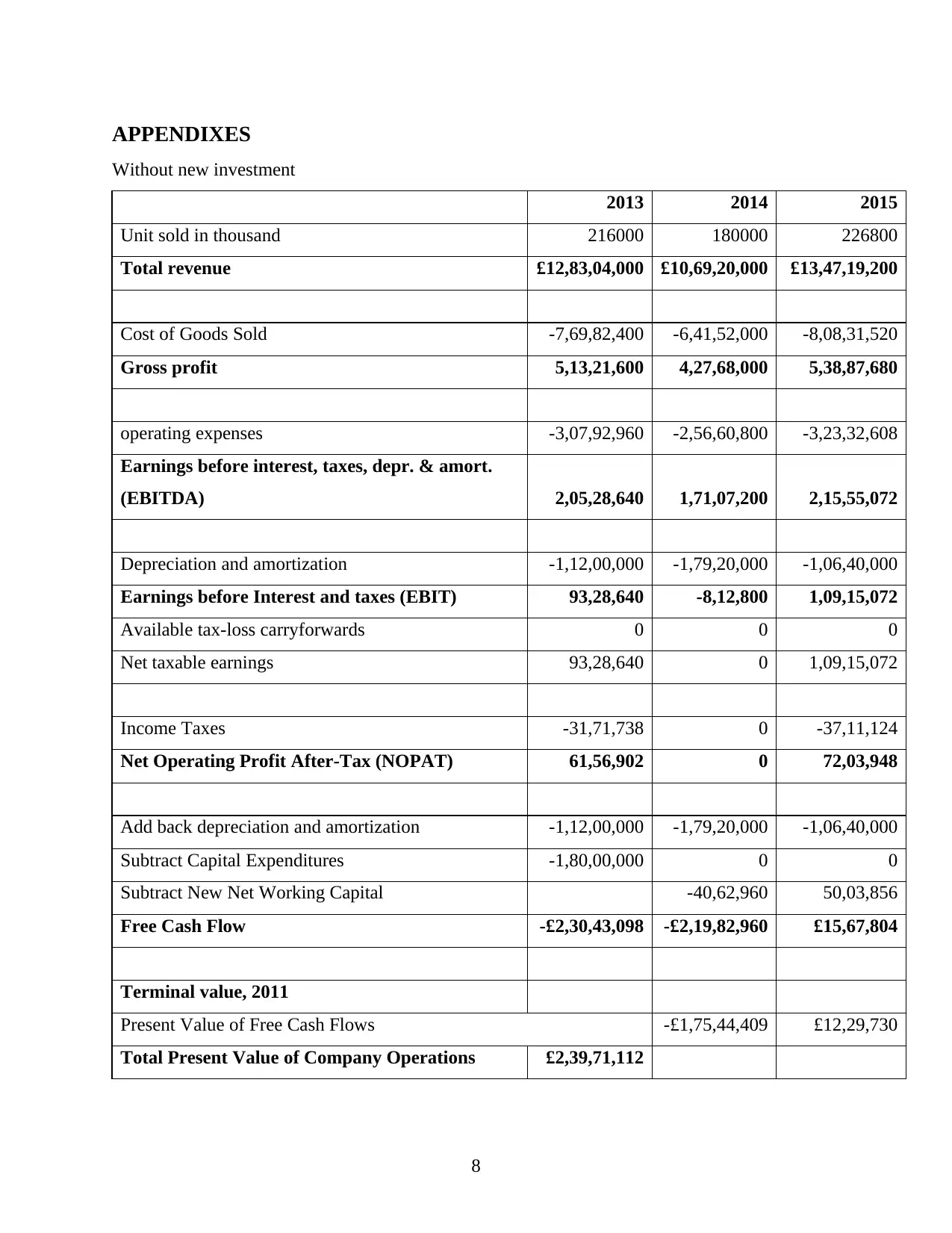
APPENDIXES
Without new investment
2013 2014 2015
Unit sold in thousand 216000 180000 226800
Total revenue £12,83,04,000 £10,69,20,000 £13,47,19,200
Cost of Goods Sold -7,69,82,400 -6,41,52,000 -8,08,31,520
Gross profit 5,13,21,600 4,27,68,000 5,38,87,680
operating expenses -3,07,92,960 -2,56,60,800 -3,23,32,608
Earnings before interest, taxes, depr. & amort.
(EBITDA) 2,05,28,640 1,71,07,200 2,15,55,072
Depreciation and amortization -1,12,00,000 -1,79,20,000 -1,06,40,000
Earnings before Interest and taxes (EBIT) 93,28,640 -8,12,800 1,09,15,072
Available tax-loss carryforwards 0 0 0
Net taxable earnings 93,28,640 0 1,09,15,072
Income Taxes -31,71,738 0 -37,11,124
Net Operating Profit After-Tax (NOPAT) 61,56,902 0 72,03,948
Add back depreciation and amortization -1,12,00,000 -1,79,20,000 -1,06,40,000
Subtract Capital Expenditures -1,80,00,000 0 0
Subtract New Net Working Capital -40,62,960 50,03,856
Free Cash Flow -£2,30,43,098 -£2,19,82,960 £15,67,804
Terminal value, 2011
Present Value of Free Cash Flows -£1,75,44,409 £12,29,730
Total Present Value of Company Operations £2,39,71,112
8
Without new investment
2013 2014 2015
Unit sold in thousand 216000 180000 226800
Total revenue £12,83,04,000 £10,69,20,000 £13,47,19,200
Cost of Goods Sold -7,69,82,400 -6,41,52,000 -8,08,31,520
Gross profit 5,13,21,600 4,27,68,000 5,38,87,680
operating expenses -3,07,92,960 -2,56,60,800 -3,23,32,608
Earnings before interest, taxes, depr. & amort.
(EBITDA) 2,05,28,640 1,71,07,200 2,15,55,072
Depreciation and amortization -1,12,00,000 -1,79,20,000 -1,06,40,000
Earnings before Interest and taxes (EBIT) 93,28,640 -8,12,800 1,09,15,072
Available tax-loss carryforwards 0 0 0
Net taxable earnings 93,28,640 0 1,09,15,072
Income Taxes -31,71,738 0 -37,11,124
Net Operating Profit After-Tax (NOPAT) 61,56,902 0 72,03,948
Add back depreciation and amortization -1,12,00,000 -1,79,20,000 -1,06,40,000
Subtract Capital Expenditures -1,80,00,000 0 0
Subtract New Net Working Capital -40,62,960 50,03,856
Free Cash Flow -£2,30,43,098 -£2,19,82,960 £15,67,804
Terminal value, 2011
Present Value of Free Cash Flows -£1,75,44,409 £12,29,730
Total Present Value of Company Operations £2,39,71,112
8
Paraphrase This Document
Need a fresh take? Get an instant paraphrase of this document with our AI Paraphraser
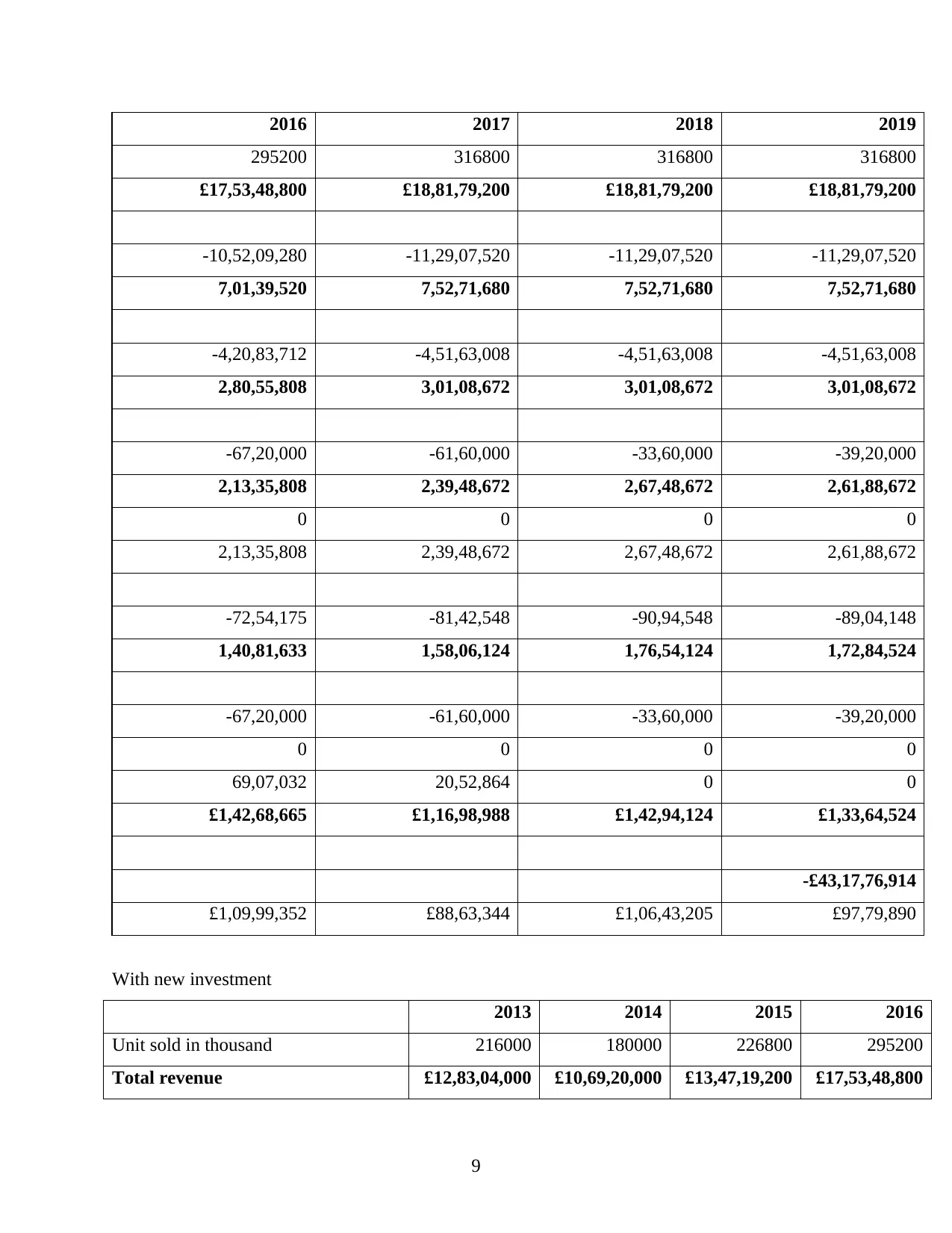
2016 2017 2018 2019
295200 316800 316800 316800
£17,53,48,800 £18,81,79,200 £18,81,79,200 £18,81,79,200
-10,52,09,280 -11,29,07,520 -11,29,07,520 -11,29,07,520
7,01,39,520 7,52,71,680 7,52,71,680 7,52,71,680
-4,20,83,712 -4,51,63,008 -4,51,63,008 -4,51,63,008
2,80,55,808 3,01,08,672 3,01,08,672 3,01,08,672
-67,20,000 -61,60,000 -33,60,000 -39,20,000
2,13,35,808 2,39,48,672 2,67,48,672 2,61,88,672
0 0 0 0
2,13,35,808 2,39,48,672 2,67,48,672 2,61,88,672
-72,54,175 -81,42,548 -90,94,548 -89,04,148
1,40,81,633 1,58,06,124 1,76,54,124 1,72,84,524
-67,20,000 -61,60,000 -33,60,000 -39,20,000
0 0 0 0
69,07,032 20,52,864 0 0
£1,42,68,665 £1,16,98,988 £1,42,94,124 £1,33,64,524
-£43,17,76,914
£1,09,99,352 £88,63,344 £1,06,43,205 £97,79,890
With new investment
2013 2014 2015 2016
Unit sold in thousand 216000 180000 226800 295200
Total revenue £12,83,04,000 £10,69,20,000 £13,47,19,200 £17,53,48,800
9
295200 316800 316800 316800
£17,53,48,800 £18,81,79,200 £18,81,79,200 £18,81,79,200
-10,52,09,280 -11,29,07,520 -11,29,07,520 -11,29,07,520
7,01,39,520 7,52,71,680 7,52,71,680 7,52,71,680
-4,20,83,712 -4,51,63,008 -4,51,63,008 -4,51,63,008
2,80,55,808 3,01,08,672 3,01,08,672 3,01,08,672
-67,20,000 -61,60,000 -33,60,000 -39,20,000
2,13,35,808 2,39,48,672 2,67,48,672 2,61,88,672
0 0 0 0
2,13,35,808 2,39,48,672 2,67,48,672 2,61,88,672
-72,54,175 -81,42,548 -90,94,548 -89,04,148
1,40,81,633 1,58,06,124 1,76,54,124 1,72,84,524
-67,20,000 -61,60,000 -33,60,000 -39,20,000
0 0 0 0
69,07,032 20,52,864 0 0
£1,42,68,665 £1,16,98,988 £1,42,94,124 £1,33,64,524
-£43,17,76,914
£1,09,99,352 £88,63,344 £1,06,43,205 £97,79,890
With new investment
2013 2014 2015 2016
Unit sold in thousand 216000 180000 226800 295200
Total revenue £12,83,04,000 £10,69,20,000 £13,47,19,200 £17,53,48,800
9
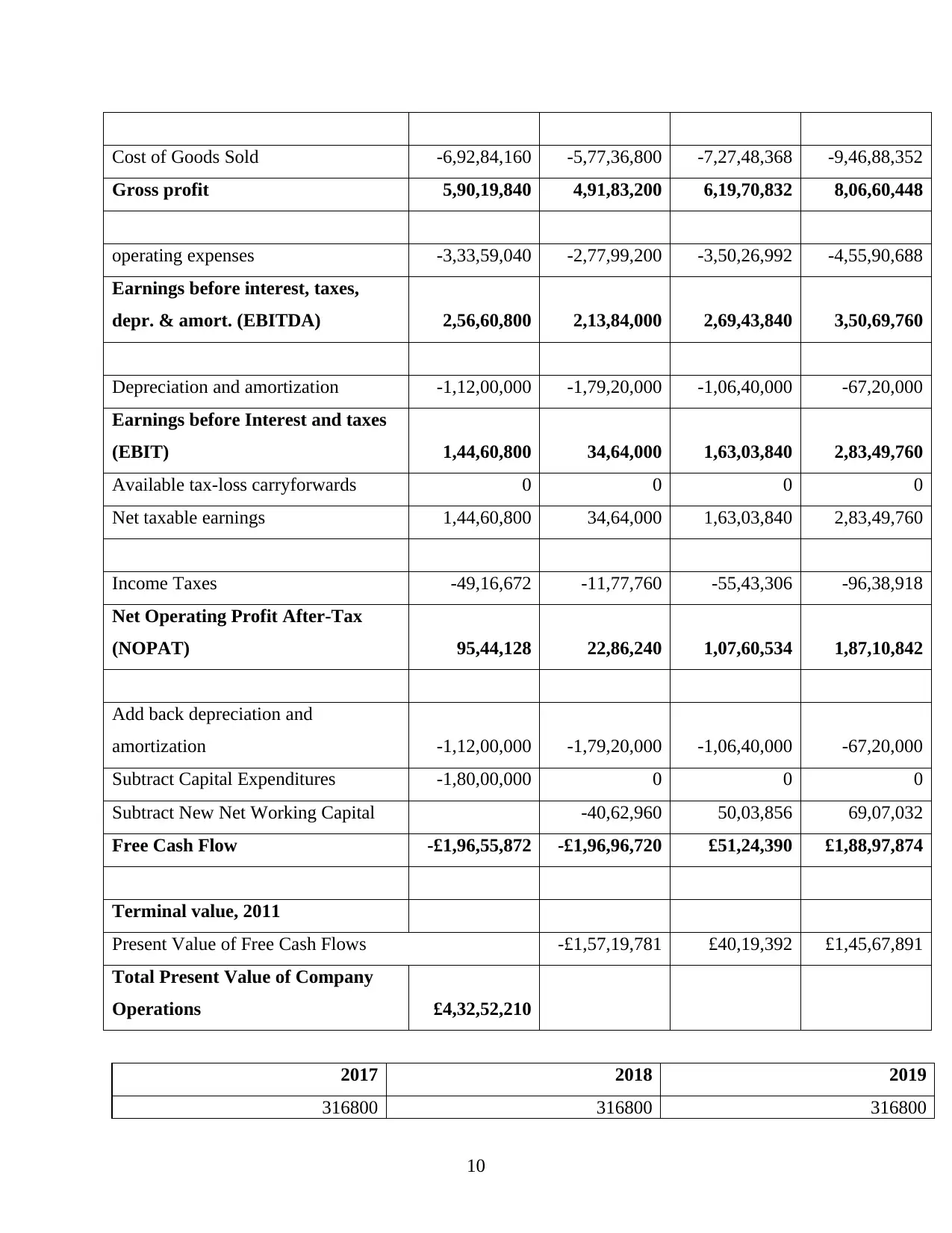
Cost of Goods Sold -6,92,84,160 -5,77,36,800 -7,27,48,368 -9,46,88,352
Gross profit 5,90,19,840 4,91,83,200 6,19,70,832 8,06,60,448
operating expenses -3,33,59,040 -2,77,99,200 -3,50,26,992 -4,55,90,688
Earnings before interest, taxes,
depr. & amort. (EBITDA) 2,56,60,800 2,13,84,000 2,69,43,840 3,50,69,760
Depreciation and amortization -1,12,00,000 -1,79,20,000 -1,06,40,000 -67,20,000
Earnings before Interest and taxes
(EBIT) 1,44,60,800 34,64,000 1,63,03,840 2,83,49,760
Available tax-loss carryforwards 0 0 0 0
Net taxable earnings 1,44,60,800 34,64,000 1,63,03,840 2,83,49,760
Income Taxes -49,16,672 -11,77,760 -55,43,306 -96,38,918
Net Operating Profit After-Tax
(NOPAT) 95,44,128 22,86,240 1,07,60,534 1,87,10,842
Add back depreciation and
amortization -1,12,00,000 -1,79,20,000 -1,06,40,000 -67,20,000
Subtract Capital Expenditures -1,80,00,000 0 0 0
Subtract New Net Working Capital -40,62,960 50,03,856 69,07,032
Free Cash Flow -£1,96,55,872 -£1,96,96,720 £51,24,390 £1,88,97,874
Terminal value, 2011
Present Value of Free Cash Flows -£1,57,19,781 £40,19,392 £1,45,67,891
Total Present Value of Company
Operations £4,32,52,210
2017 2018 2019
316800 316800 316800
10
Gross profit 5,90,19,840 4,91,83,200 6,19,70,832 8,06,60,448
operating expenses -3,33,59,040 -2,77,99,200 -3,50,26,992 -4,55,90,688
Earnings before interest, taxes,
depr. & amort. (EBITDA) 2,56,60,800 2,13,84,000 2,69,43,840 3,50,69,760
Depreciation and amortization -1,12,00,000 -1,79,20,000 -1,06,40,000 -67,20,000
Earnings before Interest and taxes
(EBIT) 1,44,60,800 34,64,000 1,63,03,840 2,83,49,760
Available tax-loss carryforwards 0 0 0 0
Net taxable earnings 1,44,60,800 34,64,000 1,63,03,840 2,83,49,760
Income Taxes -49,16,672 -11,77,760 -55,43,306 -96,38,918
Net Operating Profit After-Tax
(NOPAT) 95,44,128 22,86,240 1,07,60,534 1,87,10,842
Add back depreciation and
amortization -1,12,00,000 -1,79,20,000 -1,06,40,000 -67,20,000
Subtract Capital Expenditures -1,80,00,000 0 0 0
Subtract New Net Working Capital -40,62,960 50,03,856 69,07,032
Free Cash Flow -£1,96,55,872 -£1,96,96,720 £51,24,390 £1,88,97,874
Terminal value, 2011
Present Value of Free Cash Flows -£1,57,19,781 £40,19,392 £1,45,67,891
Total Present Value of Company
Operations £4,32,52,210
2017 2018 2019
316800 316800 316800
10
⊘ This is a preview!⊘
Do you want full access?
Subscribe today to unlock all pages.

Trusted by 1+ million students worldwide
1 out of 13
Your All-in-One AI-Powered Toolkit for Academic Success.
+13062052269
info@desklib.com
Available 24*7 on WhatsApp / Email
![[object Object]](/_next/static/media/star-bottom.7253800d.svg)
Unlock your academic potential
Copyright © 2020–2025 A2Z Services. All Rights Reserved. Developed and managed by ZUCOL.


